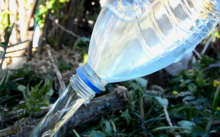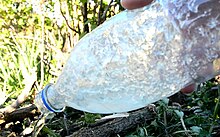
Back فرط التبريد Arabic Пераахалоджаная вадкасць Byelorussian Subfusió Catalan Podchlazení (termodynamika) Czech Underafkøling (fysik) Danish Unterkühlung (Thermodynamik) German Superfandiĝo Esperanto Sobrefusión Spanish Allajahtumine Estonian فراسرمایش Persian


Supercooling,[1] also known as undercooling,[2][3] is the process of lowering the temperature of a liquid below its freezing point without it becoming a solid. It is achieved in the absence of a seed crystal or nucleus around which a crystal structure can form. The supercooling of water can be achieved without any special techniques other than chemical demineralization, down to −48.3 °C (−54.9 °F). Supercooled water can occur naturally, for example in the atmosphere, animals or plants.
- ^ Gomes, Gabriel O.; H. Stanley, Eugene; Souza, Mariano de (2019-08-19). "Enhanced Grüneisen Parameter in Supercooled Water". Scientific Reports. 9 (1): 12006. arXiv:1808.00536. Bibcode:2019NatSR...912006O. doi:10.1038/s41598-019-48353-4. ISSN 2045-2322. PMC 6700159. PMID 31427698.
- ^ Rathz, Tom. "Undercooling". NASA. Archived from the original on 2009-12-02. Retrieved 2010-01-12.
- ^ Science Mission Directorate (April 23, 2001). "Look Ma — No Hands!: What is "Undercooling"?". NASA Science. Retrieved 13 April 2023.
© MMXXIII Rich X Search. We shall prevail. All rights reserved. Rich X Search